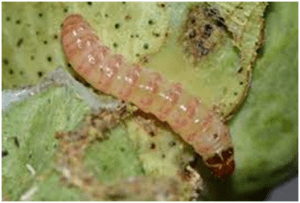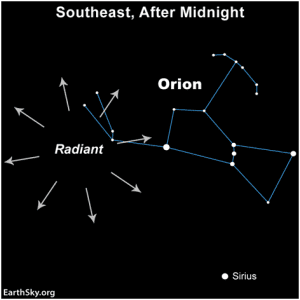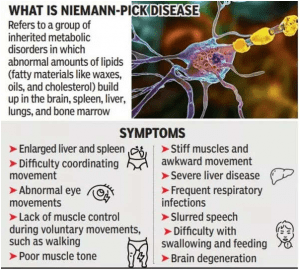1. PINK BOLLWORM
TAG: GS 3: AGRICULTURE
THE CONTEXT: The devastating impact of the pink bollworm on Bt cotton crops is a grave concern for farmers across India. The widespread infestation has resulted in significant yield losses, pushing farmers to the brink of despair.
EXPLANATION:
- Cotton crops across North Indian states, Punjab, Haryana and Rajasthan, have reported a severe pink bollworm (Pectinophora gossypiella) attack.
- In Haryana and Punjab, the losses are estimated to be around 65 per cent while Rajasthan is far worse.
- The Rajasthan government has claimed the losses extend up to 90 per cent of damage.
- Genetically modified pest-resistant variety called Bt Cotton (Bollgard II seed) is falling prey to the pest it was created to resist.
- However, the insect invasion is claiming more than just the crops the losses are pushing farmers to the brink of suicide.
- Because the severe infestation has resulted in heavy losses to farmers, burdening them with increasing debt.
- The reasons for the resurgence of pink bollworm attacks on Bt cotton in the North Zone are complex.
CONTRIBUTING FACTORS OF PINK BOLLWORM ATTACKS:
- The widespread cultivation of Bt cotton varieties that express only a single Bt toxin (Cry1Ac).
- This has allowed pink bollworm populations to develop resistance to the toxin.
- The lack of effective non-Bt pest management practices which resulted in pink bollworm populations to build up in the absence of Bt cotton.
- The use of sub-optimal insecticide dosages and spray intervals. This has allowed pink bollworm larvae to survive and complete their development.
PINK BOLLWORM:
- It is a major pest of cotton, causing significant yield losses worldwide.
- It is originally native to India but now it is recorded in nearly all the cotton-growing countries of the world.
- The larvae of the pink bollworm bore into cotton bolls, feeding on the developing seeds. This can result in significant yield losses, as well as reduced seed quality.
- It is one of the most destructive pests of cotton.
- Pectinophora gossypiella is its scientific name.

DESCRIPTION:
- The adults are small moths about 3/8 inch long and are dark brown with markings on the fore wing.
- The larval stage is the destructive and identifiable stage.
- The larvae have distinctive pink bands and can reach a length of ½ inches right before they pupate.
ECOLOGICAL THREAT:
- Pink bollworms are major pests of cotton.
- Adults only last for 2 weeks, but females will lay 200 or more eggs.
- Adults lay eggs on cotton bolls; once hatched, the larvae eat the seeds and damage the fibers of the cotton, reducing the yield and quality.
- When the larvae mature, they cut out the boll and drop to the ground and cocoon near the soil surface.
- It has also been observed to attack hibiscus, okra, and hollyhock plants.
BT COTTON:
- Bt cotton has been genetically modified by the insertion of one or more genes from a common soil bacterium, Bacillus thuringiensis.
- These genes encode for the production of insecticidal proteins, and thus, genetically transformed plants produce one or more toxins as they grow.
- The genes that have been inserted into cotton produce toxins that are limited in activity almost exclusively to caterpillar pests (Lepidoptera).
- However, other strains of Bacillus thuringiensis have genes that encode for toxins with insecticidal activity on some beetles (Coleoptera) and flies (Diptera).
- Some of these genes are being used to control pests in other crops, such as corn.
BENEFITS OF BT COTTON:
- Increased yields
- Reduced insecticide use
- Improved fiber quality
- Reduced environmental impact
- Increased farmer income
2. ORIONID METEOR SHOWER
TAG: GS 3: SCIENCE AND TECHNOLOGY
THE CONTEXT: The Orionid meteor shower peak will occur on October 20–21 and it is active from September 26 to November 22.
ORIONID METEOR SHOWER:
- It occurs in October each year, appear to be originating near the constellation Orion the Hunter.
- Orionids are caused by the debris of a comet that once crossed Earth’s path.
- In this case, the shower is caused by debris from Halley’s Comet, also known as comet 1P/Halley.
- The comet’s 76-year orbit brings it close enough to Earth to have been seen in the night skies for centuries.
- It last passed close to Earth in 1986 and will return in 2061.
- The Orionid meteor shower typically peaks between October 20 and 22.
- During the peak, observers can expect to see up to 20 meteors per hour. The meteors are known for their speed and brightness, and they can often leave persistent trains in the sky.
- Halley’s Comet, measuring about five by nine miles in size, loses between three to ten feet of material on each passage through the inner solar system.
- The Orionids are visible in both the Northern and Southern hemispheres during the hours after midnight.

METEOR:
- When meteoroids enter Earth’s atmosphere at high speed and burn up, the fireballs or “shooting stars” are called meteors.
- Meteor showers occur annually or at regular intervals as the Earth passes through the trail of dusty debris left by a comet.
- Meteor showers are usually named after a star or constellation that is close to where the meteors appear in the sky.
3. NIEMANN-PICK
TAG: GS 2: GOVERNANCE AND SOCIAL JUSTICE
THE CONTEXT: Parents of children with Niemann-Pick disease have recently sent a request to the Union government requesting it to notify the disease under the National Policy for Rare Diseases.
EXPLANATION:
Niemann-Pick Disease:
- This rare genetic illness causes sphingomyelin to build up in cell lysosomes and is caused by a malfunction in the metabolism of sphingolipids.
- The three most widely known varieties are Types A, B, and C of Niemann-Pick.
- The liver, spleen, bone marrow, brain, nerves, and, in extreme situations, the lungs can all be impacted by this illness.
- People with this condition experience symptoms related to progressive loss of function of nerves, the brain and other organs.
- Although it can happen to anyone at any age, children are the ones who are most affected.
CAUSES:
- It is inherited in a c pattern, which means both copies of the gene must be defective to cause the disease.
- Most often, the parents of a child with an autosomal recessive disorder are carriers: they have one copy of the altered gene but are not affected because the other copy produces the enzyme.
- If both parents are carriers, each pregnancy has a 25% chance of producing an affected child.
SYMPTOMS:
- Enlargement of the liver and spleen (Hepatosplenomegaly)
- Low levels of platelets in the blood (Thrombocytopenia)
- Slurring of speech (dysarthria)
- Difficulty in swallowing (dysphagia)
- Abnormal posturing of the limbs, trunk, and face (dystonia).
- Voluntary rapid eye movements (supranuclear gaze palsy).
- Gradual loss of intellectual abilities, causing dementia and seizures
CLASSIFICATION:
- Types A and B:
- Mutations in the SMPD1 Gene cause types A and B.
- They produce a deficiency in the activity of the lysosomal enzyme acid sphingomyelinase that breaks down the lipid sphingomyelin.
- Types C:
-
- Mutations in NPC1 or NPC2 cause Niemann–Pick disease, type C (NPC), which affects a protein used to transport lipids. It is the most common form of the disease including types C1 (95% of type C) and C2.
TREATMENT:
- No specific treatment is known for type A and B, but symptoms are treated.
NATIONAL POLICY FOR RARE DISEASES:
- The Government has launched National Policy for Rare Diseases (NPRD), 2021 in March, 2021 for the treatment of rare disease patients.
- The salient features of NPRD, 2021 are as under:
- The rare diseases have been identified and categorized into 3 groups namely Group 1, Group 2 and Group 3.
- Group 1: Disorders amenable to one-time curative treatment.
- Group-2: Diseases requiring long term/lifelong treatment having relatively lower cost of treatment and benefit has been documented in literature and annual or more frequent surveillance is required.
- Group 3: Diseases for which definitive treatment is available but challenges are to make optimal patient selection for benefit, very high cost and lifelong therapy.
PROVISIONS UNDER THE POLICY:
- It provides the provision for financial support of up to Rs. 50 lakhs to the patients suffering from any category of the Rare Diseases and for treatment in any of the Centre of Excellence (CoE) mentioned in NPRD-2021, outside the Umbrella Scheme of Rashtriya Arogaya Nidhi.
- To receive financial assistance for treatment of rare disease, the patient of the nearby area may approach the nearest Centre of Excellence to get him assessed and avail the benefits.
- Eight (08) Centres of Excellence (CoEs) have been identified for diagnosis, prevention and treatment of rare diseases.
- Five Nidan Kendras have been set up for genetic testing and counselling services.
- It also facilitate promotion of research and development for diagnosis and treatment of rare diseases; promotion of local development and manufacture of drugs and creation of conducive environment for indigenous manufacturing of drugs for rare diseases at affordable prices.

4. POSH (PREVENTION OF SEXUAL HARASSMENT) ACT, 2013
TAG: GS 2: SOCIAL JUSTICE
THE CONTEXT: The Supreme Court issued a series of directions to the Centre, states and Union Territories, flagging gaps and lack of uniformity in the implementation of the POSH (Prevention of Sexual Harassment) Act, 2013 by various state governments.
EXPLANATION:
- The judgement came on a petition by an NGO, Initiatives for Inclusion Foundation, seeking directions for implementation of the Act.
- Among others, the petitioner also urged the court to direct the different governments to ensure that the annual compliance reports collected by the district officers are consolidated and the reports are published in the public domain.
KEY DIRECTIONS ISSUED BY THE SUPREME COURT:
- The court ordered the Principal Secretaries of the Women and Child Ministries in the States to ensure appointment of a district officer in each district within their jurisdiction within four weeks from the date of this judgment as contemplated under Section 5 of the POSH Act.
- The undertaking of efforts to spread awareness about the existence of Local Committees (LCs) among workers in the unorganized sector.
- The ensuring of compliance with the provisions of the Act by all employers.
- The providing of training for Internal Complaints Committees (ICCs) on the proper conduct of inquiries into complaints of sexual harassment.
- The ensuring of transparency in the disposal of complaints of sexual harassment.
POSH Act, 2013:
- The POSH Act is a legislation enacted by the Government of India in 2013 to address the issue of sexual harassment faced by women in the workplace.
- The Act aims to create a safe and conducive work environment for women and provide protection against sexual harassment.
- The POSH Act defines sexual harassment to include unwelcome acts such as
- physical contact and sexual advances,
- a demand or request for sexual favours,
- making sexually coloured remarks,
- showing pornography, and
- any other unwelcome physical, verbal, or non-verbal conduct of a sexual nature.
- The Supreme Court in a landmark judgment in the Vishakha and others v State of Rajasthan 1997 case gave ‘Vishakha guidelines’.
- These guidelines formed the basis for the Sexual Harassment of Women at Workplace (Prevention, Prohibition and Redressal) Act, 2013.
- The SC also drew its strength from several provisions of the Constitution including:
- Article 15 (against discrimination on grounds only of religion, race, caste, sex, and place of birth),
- Relevant International Conventions and norms such as the General Recommendations of the Convention on the Elimination of All Forms of Discrimination Against Women (CEDAW), which India ratified in 1993.
KEY PROVISIONS:
- Prevention and Prohibition:
- The Act places a legal obligation on employers to prevent and prohibit sexual harassment in the workplace.
- Internal Complaints Committee (ICC):
- Employers are required to constitute an ICC at each workplace with 10 or more employees to receive and address complaints of sexual harassment.
- The Complaints Committees have the powers of civil courts for gathering evidence.
- Duties of Employers:
- Employers must undertake awareness programs, provide a safe working environment, and display information about the POSH Act at the workplace.
- Complaint Mechanism:
- The Act lays down a procedure for filing complaints, conducting inquiries, and providing a fair opportunity to the parties involved.
- Penalties:
-
- Non-compliance with the Act’s provisions can result in penalties, including fines and cancellation of business licenses.
5. SOUTHWEST MONSOON
TAG: GS 1: GEOGRAPHY
THE CONTEXT: As per the India Meteorological Department (IMD), the southwest monsoon has ended, and the northeast monsoon is likely to set in the end of the October.
EXPLANATION:
- The 2023 southwest monsoon season was not only the weakest in five years but was also marked by erratic distribution of rains.
- June received 9% below normal rainfall, while July brought torrential downpour and floods across man regions in northern India.
- August was the driest month on record in 100 years, with 36% below normal rainfall.
- September saw some recovery with showers 13% above normal, but the four-month monsoon season ended with 6% below normal rainfall.
- Rains in the June-September season drives the bulk of India’s $3 trillion economy.
- It accounts for nearly 75% of the country’s annual rainfall, which plays a crucial role the agriculture, replenishes reservoirs and aquifers, and helps meet power demand.
- Over half of India’s arable land is rain-fed and agriculture remains among the biggest employment generators.
- The southwest monsoon is also crucial as ensures soil moisture when farmers begin planting rabi, or winter, crops such as wheat, the main crop of the season, chana (gram), mustard, among others.
SOUTHWEST MONSOON:
- The southwest monsoon is a seasonal wind system that brings rainfall to India and other parts of South Asia.
- It originates in the southern hemisphere, where it is known as the trade winds.
- As the trade winds cross the equator, they are deflected to the left by the Coriolis force, becoming the southwest monsoon.
- The southwest monsoon typically arrives in India in early June and lasts until September.
- It is responsible for about 80% of the country’s annual rainfall. The monsoon is vital for India’s agriculture, as it provides the water needed for crops to grow.
- The southwest monsoon is a complex weather system that is influenced by a number of factors, including the El Niño-Southern Oscillation (ENSO).
- ENSO is a climate pattern that involves changes in sea surface temperatures in the Pacific Ocean.
- When ENSO is in its El Niño phase, the southwest monsoon is typically weaker than usual. This can lead to drought conditions in India.
- The southwest monsoon is a vital part of India’s climate and economy.
- The monsoon provides the water needed for agriculture, which is the backbone of the Indian economy. The monsoon also helps to regulate temperatures and reduce the risk of heatwaves.
NORTHEAST MONSOON:
- It is a comparatively small-scale monsoon, which is confined to the Southern peninsula.
- It is called the winter monsoon. It occurs during October to December.
- After the complete withdrawal of the Southwest monsoon from the country takes place by mid-October, the wind pattern rapidly changes from the south-westerly to the north-easterly direction.
- The period after the Southwest monsoon season, from October to December, is the peak time for cyclonic activity in the North Indian Ocean region covering the Arabian Sea and the Bay of Bengal.
- The winds associated with the formation of low pressure systems, depressions, or cyclones influence this monsoon, and therefore, the rainfall.
- Its rainfall is influenced by global climate parameters such as ENSO (El Nino/La Nina & Southern Oscillation Index – SOI), Indian Ocean Dipole (IOD) and Madden-Julian Oscillation (MJO).
- El Nino, positive IOD and MJO in phase 2-4 with amplitude greater than one are generally associated with good NEM rainfall.
- Also, La Nina & positive SOI during the second half of the season is also favourable for good NEM activity.

